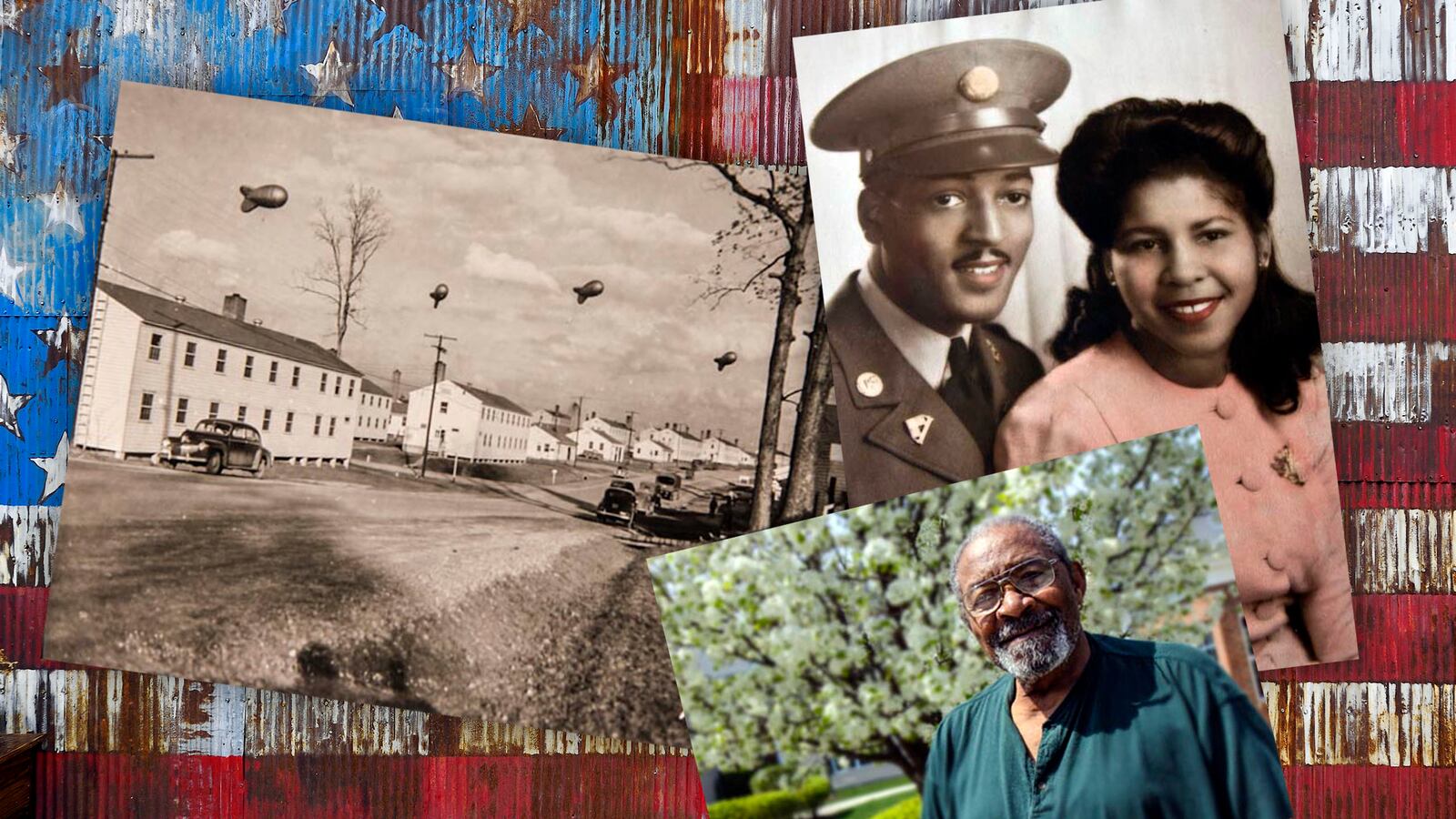In a little-known chapter of World War II, thousands of African-American troops trained to fly barrage balloons, defensive weapons used to protect Allied soldiers from dive-bombing enemy planes during the D-Day invasion. This is their story.
Linda Hervieux
Part 1: Paris, Tennessee
Wilson Caldwell Monk stepped off a train car in a quiet corner of northwestern Tennessee in September 1942 that was a world away from his native Atlantic City, with its crowds of pleasure-seeking tourists, amusements and marquee performers.
The 23-year-old Army private was the farthest south he had ever been, and like many Black recruits from the North, he was nervous. They had heard stories about the Deep South, about Black men being arrested and pressed into service on chain gangs. Monk would learn that you couldn't look a white person in the eye, and that you had to step off a sidewalk if one was coming at you. That was the law under Jim Crow.

Wilson Monk and his sweetheart, Mertina, posed for a portrait in Atlantic City during the war.
Courtesy Monk FamilyOn his first train ride south to boot camp in Maryland, Monk, soft-spoken and exceedingly polite, had been asked to move to the "Negro car," always the last car by the filthy coal engine. Later, he would brush off the black soot sullying his khaki uniform. He was already seething. And it only got worse.
But when Monk and his fellow recruits disembarked in a town called Paris and observed a pastoral landscape of green fields and forests, the South didn't seem so bad. A heavy rucksack on his shoulder, Monk stared up at the sky, dotted with sausage-shaped orbs bigger than school buses.
Monk was assigned to the 320th Barrage Balloon Battalion, a specialty unit the Army created to protect Americans from dive-bombing enemy planes. The men of the 320th would storm the beaches of Normandy in June 1944—the only Black combat unit—alongside the infantry, carrying silvery balloons. Except those balloons would be armed with a top-secret lethal surprise.
The 320th men would win accolades for their service on D-Day and return home as celebrities. But in the years to come, their story would be all but erased from the record. Few books on D-Day mention the Black balloon flyers, and no movies about that epic day show Black troops, though the balloons are visible in Saving Private Ryan.
The 320th was one of two black units at D-Day to receive a commendation from Gen. Dwight D. Eisenhower. A battalion medic injured in the landing, Waverly Woodson, Jr., saved scores of lives and was nominated for the Medal of Honor. He never received it. No Black soldiers were awarded the country's highest honor during World War II. (There is a campaign under way to change that.)

Barrage Balloons fly over Camp Tyson, Tennessee, during World War II.
Courtesy National ArchivesThe United States came late to idea of using barrage balloons. The hydrogen-filled spheres were already flying over Britain, Russia, Germany and Japan in December 1941 when the Japanese attacked Pearl Harbor. It was the exact sort of assault the balloons were designed to prevent. With strong steel cables anchored to the ground, the balloons could ensnare the wings of a plane, causing it to stall and crash. And the gasbags forced pilots to fly higher, giving anti-aircraft artillery guns on the ground a better shot at them. They weren't as effective in protecting a sprawling city like London, but they were perfect for keeping planes away from a target such as a power plant, a beach—or a Navy base. One day before Japanese bombs devastated the U.S. Pacific fleet, a spy in Honolulu reported back to Tokyo that "there are no signs" of barrage balloons.
A year earlier, Monk had been waiting tables at Heilig's Restaurant on the famed Atlantic City Boardwalk, serving up specialties like stewed snapper to well-heeled diners. Now, he was learning to make highly flammable hydrogen gas, predict weather patterns, gauge wind speed, and other tasks necessary to keep the balloons in the air, and to keep safe the men on the ground handling them.
Monk was taught the workings of the balloons' secret weapon, 4-pound bombs the size of soda cans that would be anchored to the balloons that went to battle. With a cable strike, the bombs would descend. A good hit could blow off a wing or ignite the gas tank. The Army took pains to keep the weapons secret, but propaganda hinted at the balloons' deadly booby trap. German pilots were terrified of them.
"Every man thought it was an important job," Monk told me. "As big as the Army was, it only had a few barrage balloon battalions."
Of the more than 30 barrage balloon units that would train at Camp Tyson during the war, four were all-Black, which in the segregated Army meant the troops were Black and the top officers were white. Black soldiers had their own barracks and mess halls. At first, some were not aware they shared the base with white soldiers. On and off base, they were routinely harassed by white military police officers. At Monk's previous post at Fort Eustis in Virginia, tensions flared after a white MP killed a Black soldier. "That is the second murder of its kind in two weeks," Monk wrote to his mother, Rosita, in June 1941.
Camp Tyson was on high alert for riots in June 1943 after a Black 320th soldier, Herman "Hank" Hankins, was shot in the back off base. A white soldier told investigators he fired at a fleeing "prowler" who was peeping in windows and refused orders to stop, though other 320th men disputed those facts. "He wouldn't have gone looking in windows," Monk said. "That was the excuse they gave." After Hankins' death, Black soldiers were scared to go into town.
Another 320th soldier, Samuel L. Mattison, said he didn't want to go into Paris because "every time you go to town, someone gets beat up." But it was during one of those times that he suffered a vicious beating by two MP's and a pair of white civilian cops. Mattison got his revenge, breaking the fingers of one cop who cracked him in the head with a billy club. Mattison, under arrest, was relieved when he was taken back to base because in a civilian jail, he said, "they'd probably hang me." Records show Mattison was court-martialed.

Samuel L. Mattison in 2010. He once broke a racist MP’s fingers.
Courtesy Linda HervieuxMattison, a street-smart orphan from Columbus, Ohio, never got used to life in the South, and the bad treatment Black men were supposed to tolerate, the daily indignities and racial slurs. "Black men ain't no men," he told me in 2010, nine months before he died at age 92. "We were like little dogs."
It was on a weekend pass to Memphis that Monk learned the extremes of racism. Eager to blow off steam and hear some blues on Beale Street, the men stopped to grab some drinks at a diner. Monk plopped a 50-cent coin on the counter and asked for change to play the jukebox. The barman glared at him, retrieved some nickels from the register and threw them across the counter. "If you wasn't in uniform," the man told Monk, "you wouldn't get nothing from me."
It could have been worse. Southern whites were known to regard a Black man wearing a uniform as a provocation, and many would be brutally beaten when they returned home from the war, just had they had been after World War I.
Later that day, when Monk and his friends stopped for a bite, they were stunned to see a line of enemy prisoners of war filing into a restaurant where Black men—even soldiers—were not welcome. The 425,000 German and Italian POWs interned at U.S. Army bases during the war often enjoyed privileges denied to the African Americans stationed there.
"It really hurt us," Monk recalled, the wound still fresh seven decades after the war. White guards shared cigarettes with their charges while spitting out expletives at men like Monk. A Black soldier in Texas fumed at "American MPs and some of Hitler's bully boys… having a ball together, wining and dining."
After tensions flared at Camp Lawton in Seattle, Black soldiers were charged with attacking Italian POWs, killing one. They were disciplined in the largest court-martial of the war, though their convictions were dismissed in 2008 after the Army concluded their trial included a cover-up and was "fundamentally unfair."
As racial tensions mounted, a War Department order banning white commanders from using slurs and abusive language went largely ignored. Appalling treatment of Black soldiers would be blamed, in part, for more than 240 race riots that erupted across the country in 1943.
Monk was hardly naïve. He knew racism was alive and well in the North, too. As a boy he watched the Ku Klux Klan burn a cross near his family's home in Pleasantville, N.J. He noted that he was not welcome to dine at any of the restaurants where he worked on the Atlantic City Boardwalk. But somehow this was worse. He was willing to fight for his country, and he expected better treatment.
Still, Monk said, he and his fellow soldiers of color were ready to die so that others, far away, would live free. "There was never any doubt about the loyalty of Black soldiers," he said. "Even considering the fact that we weren't treated equally."
Next: The balloon flyers go to war
Linda Hervieux is the author of Forgotten: The Untold Story of D-Day's Black Heroes, At Home and At War (Harper). For more on the men of the 320th, go to www.lindahervieux.com.








